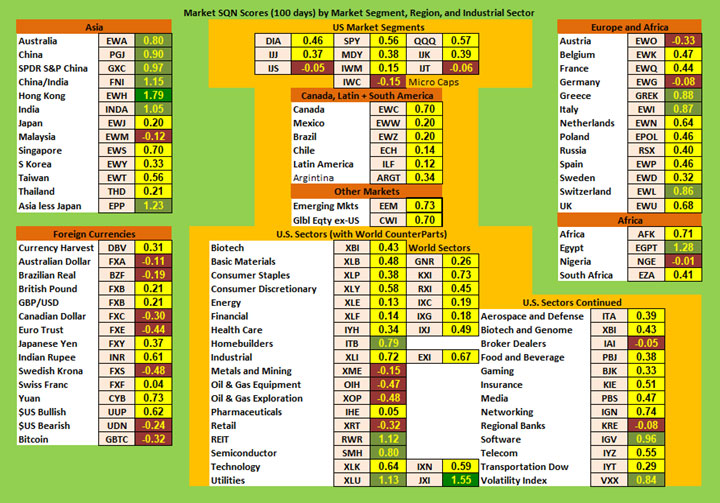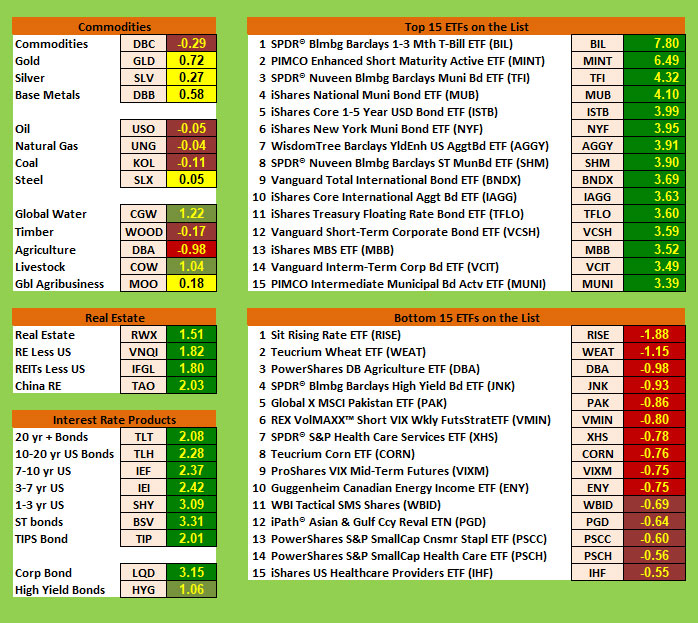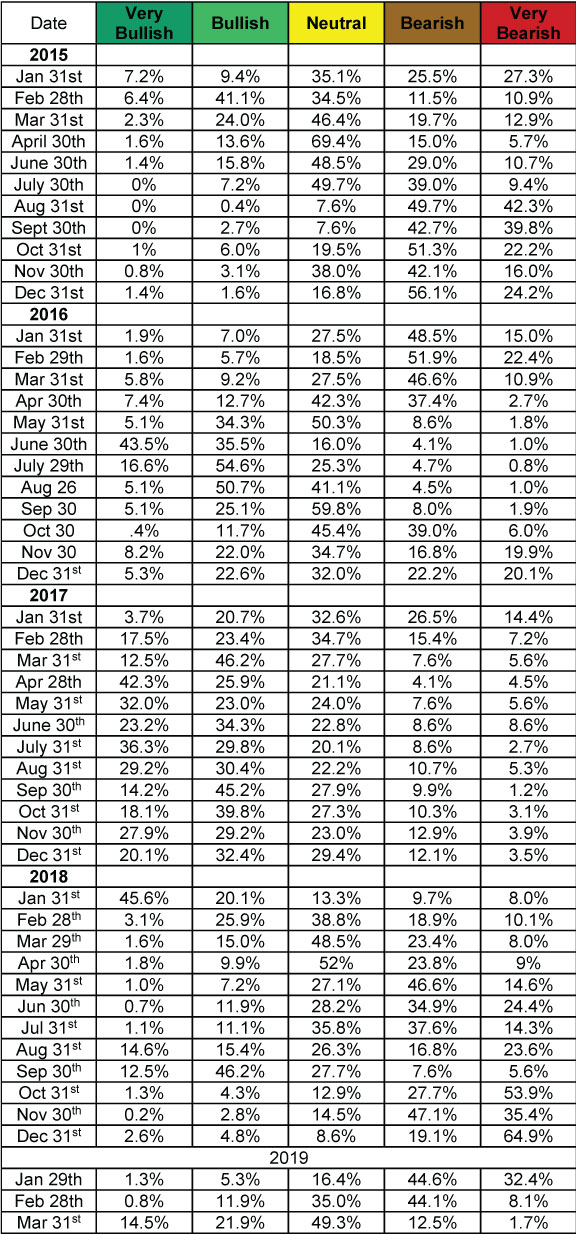 There are numerous ETFs that track everything from countries, commodities, currencies and stock market indices to individual market sectors. ETFs provide a wonderfully easy way to discover what’s happening in the world markets. I apply a version of my System Quality Number® (SQN®) score to measure the relative performance of numerous markets in a world model.
There are numerous ETFs that track everything from countries, commodities, currencies and stock market indices to individual market sectors. ETFs provide a wonderfully easy way to discover what’s happening in the world markets. I apply a version of my System Quality Number® (SQN®) score to measure the relative performance of numerous markets in a world model.
The Market SQN score uses the daily percent change for input over a 100-day period. Typically, a Market SQN score over 1.47 is strongly bullish and a score below -0.7 is very weak. The following color codes help communicate the strengths and weaknesses of the ETFs in this report:
- Dark Green: ETFs with very strong Market SQN scores > 1.47
- Light Green: ETFs with strong Market SQN scores (0.70 to 1.47).
- Yellow: ETFs with slightly positive Market SQN scores (0 to 0.70). These are Neutral/Sideways
- Brown: ETFs with slightly negative Market SQN scores (0 to -0.7).
- Red: Very weak ETFs that earn negative Market SQN scores (< -0.7).
This is basically the same rating scale that we use for the Market SQN Score in the Market Update. The world market model spreadsheet report below contains a cross section of currently available ETFs; excluding inverse funds and leveraged funds. In short, it covers equity markets around the globe, major asset classes, equity market segments, industrial sectors, and major currencies.
World Market Summary — Equities & Currencies
Each month we look at the equities markets across the globe by segment, region, and sector.
While all of the markets continue to look weak, there are no red symbols and very few brown symbols. Almost all of them are yellow.
The US Dollar remains in a trading range where it has been since the 3rd quarter of last year. That range is still a strong level compared to where it has been in the last 10-15 years but the long-term advance has turned sideways — and its Market SQN score reflects that. The US Dollar Bullish is yellow this month.
Most US equity segments were uniformly brown last month while this month they are mostly yellow with some brown. Elsewhere in the Americas, everything is yellow. Europe is mostly yellow with a few greens and a few browns. Greece, Italy, and Switzerland are all light green. Austria and Germany are brown.
In Africa, Egypt is green while Nigeria is brown.
Asia, however, is looking much stronger with mostly yellow and green. And Hong Kong stands out as being dark green. Australia, China, and India are all light green.
Currencies at the end of March are uniformly weak — either being yellow or brown. The Euro and the Swedish Krona are the weakest currencies. Bitcoin still shows up as weak, but cryptos in the March 15th report were showing a bullish trend. And in the last two days, not shown here, BTC has jumped over 20%. It’s clearly broken out of a bearish trend that lasted all of 2018.
Commodities, Real Estate, Debt, and the Top and Bottom Lists
Commodities were mixed with a varied range of Market SQN scores. Livestock is the strongest commodity and global water is also strong. The weakest commodity is agriculture. Oil, natural gas, timber and coal are brown. Gold, silver and the base metals are yellow
Because interest rates are not going up any more, the interest sector is all dark green with some SQN® 100 scores being over 3.0. Real estate is also dark green.
All of the symbols in real estate and debt categories were positive — with more real estate representatives yellow.
What’s really interesting is that the 15 strongest ETFs are all dark green with the lowest score (#15 being above 3.3). And the highest score is something I’ve never seen before. The highest rated ETF (short term bills) has an SQN score of 7. I’ve never seen one above 5 before for an ETF.
On the negative side, only 10 of the bottom ETFs were red, the rest were brown. And none of the weak ETFs has a score any lower than minus 1.88 — which is a positive side.
Summary
Let’s look at the summary table which measures the percentage of ETFs in each of the strength categories. You can see the distribution of the database by Market SQN score in bullish, neutral and bearish categories below —
You can see the shift for so much of the database out of the very bearish category four months ago and into the neutral category. In fact, we have over 10% very bullish for the 1st time since Sept 30th. Furthermore, only 14.2% of the over 600 ETFs that we track are bearish.
Will we be back to bull next month? Stay tuned to see. However, I think the huge 2019 bull market in cryptos is well underway. Super Traders, you have had your instructions on what to do and you should have your positions by now. With BTC briefly going over $5000 on Tuesday, you probably have about a 40% risk now, but that’s small compared with the potential gain in 2019.
Be careful to base your actions upon what IS happening, not what you think might happen. The markets always offer opportunities, but to capture those opportunities, you MUST know what you are doing. If you want to trade these markets, you need to approach them as a trader, not a long-term investor. We’d like to help you learn how to trade professionally because trying to navigate the markets without an education is hazardous to your wealth. All the beliefs given in this update are my own. Though I find them useful, you may not. You can only trade your own beliefs about the markets.



